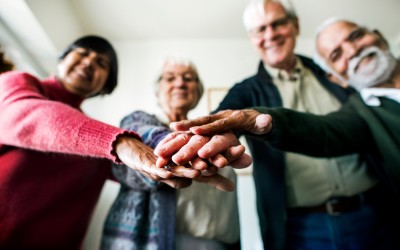In this time of stress and uncertainty, networks can be especially valuable for your program participants. Indeed, the long term social and economic effects of this pandemic are going to be significant. Now may be the best time to connect participants to each other and additional people and institutions to support them.
Viewpoints on Resilient & Equitable Responses to the Pandemic. Anita Brown-Graham: Social Capital
Part of the series “Viewpoints on Resilient and Equitable Responses to the Pandemic” from the Center for Urban and Regional Studies at The University of North Carolina at Chapel Hill.
The COVID-19 pandemic is causing people around the world to question how this virus will affect the many public and private systems that we all use. We hope this collection of viewpoints will elevate the visibility of creative state and local solutions to the underlying equity and resilience challenges that COVID-19 is highlighting and exacerbating. To do this we have asked experts at UNC to discuss effective and equitable responses to the pandemic on subjects ranging from low-wage hospitality work, retooling manufacturing processes, supply chain complications, housing, transportation, the environment, and food security, among others.
Anita Brown-Graham is a professor of public law and government at the UNC School of Government and director of the ncIMPACT project. She’s been working for the past year with a team at the UNC School of Government, RTI International and the Office of the Assistant Secretary to Planning and Evaluation at the United States Department of Health and Human Services, to identify ways to strengthen human services through social capital.
Transcript – Viewpoints on Resilient & Equitable Responses to the Pandemic. Anita Brown-Graham: Social Capital
Many of us have spent our first weeks of social distancing fighting against loneliness by using virtual platforms, such as Zoom, Google Hangouts, WebEx, Facebook and Instagram, or just our telephones, as our means of staying together.
It’s notable that the connections that may be helpful to most of us may actually be essential to others; and, as a result, some human service agencies are quickly moving to using these online platforms and telephones to help their program participants continue to build and leverage the social connections critical to program success. Indeed, as just one example, Alcoholics Anonymous recently announced that it is moving its regular peer group meetings online to facilitate critical connections.
You may be wondering why connections may be so critical for human service program participants. The answer lies in the value that is derived from these connections. This value is called “social capital” and it is an important resource for all of us in life. Social capital can be accessed or mobilized to help us succeed by producing resources that include information, emotional support and financial assets. Maybe you remember the old adage, “it’s not just what you know, but who you know?” Well, there is actually research to prove it’s true.
The research on social capital suggests the key to building it is helping people to develop an increased sense of trust as they connect with other people, this makes it easier for them to work together. So, the more we connect with other people, then, the more we trust them and, the more we trust, the more we are able to effectively work together to reach shared goals. Even in today’s world of social distancing, without the facial expressions and nonverbal cues afforded in face-to-face connections, people can build trust through telephone and online interactions.
As human service agencies move to help their program participants take social capital activities online, it is important to be clear about the purpose for the social capital – that is, understanding what program-related purpose the connections seek to serve. Researchers and policymakers commonly discuss the following three types of social capital in considering purpose:
-
- Bonding social capital refers to the relationships built among individuals who share characteristics, experiences, or group membership in common (“people like me”). These are the connections that help program participants connect to those who are similarly situated and they help each other to “get by.”
- Bridging social capital refers to relationships built among individuals, communities, or groups with differing background characteristics or group membership (“people different from me”). These connections between social groups, social class, race, religion or other important sociodemographic or socioeconomic characteristics are the ones that help participants with the connections that help them “get ahead” in life.
- Linking social capital is an extension of bridging capital and it focuses on networks and organizations that provide connections across power dynamics, giving access to more resources. These connections help program participants develop relationships with people or institutions in positions of power to “get a hand up?”
In this time of stress and uncertainty, networks can be especially valuable for your program participants. Indeed, the long term social and economic effects of this pandemic are going to be significant. Now may be the best time to connect participants to each other and additional people and institutions to support them.
There are several research studies that suggest a person’s bridging and linking ties may increase more easily than bonding capital online, though, because technology is suited to maintaining these links cheaply and without high barriers. Email, Twitter and LinkedIn are particularly useful tools for making connections to people who are needed for bridging and linking capital.
I want to be clear though, that there is also plenty of research that notes bonding capital can be built online or by phone, especially when it is augmenting face to face interactions or building on existing relationships. Facebook groups, WhatsApp, Next Door and text-message based groups may be particularly helpful in leveraging the bonding social capital that may already exist among program participants or help you to begin building it.
As you think about your options for building bonding capital in particular, you may think about using “live events” on some of the platforms to replace in-person meetings that had to be canceled due to COVID-19 related restrictions on the size of gatherings. But note, whether “live” or not, expect in these challenging times that, in addition to your program content, participants will use the opportunity to seek needed information about resources from others. That is the beauty of social capital!
Before I close, I want to share ten good questions to ask yourself before you decide on a platform to launch a virtual group:
- How is social capital an asset to your program goals?
- What type of social capital are you trying to build?
- Will you need an effective facilitator to get the group started and keep it going?
- Have you determined whether (or how often) there will be live activities that require everyone to be online at the same time?
- If the group is closed (predetermined membership), have you decided when or whether to allow new members into the group?
- Will you include program alumni to participate in the group as role models?
- How structured or organic do you want interactions among the group to be?
- As an organization, how will you use your platform to broker relationships that you have to build the social capital of your individual participants?
- How will you communicate the level and methods of accountability that participants and the program have to each other?
- How will you measure whether your platform engagements are actually building social capital?
For more information about human service agencies and social capital online or by phone, see blog.ncimpact.sog.unc.edu.
The material for this podcast has been adapted from content based on: information gathered by engaging a panel of national experts for interviews and focus groups; conducting a national program scan of notable human services programs using social capital; visiting agencies in person; and, writing in-depth case studies with selected programs. That content has been augmented by research on virtual communities conducted by Anita Brown-Graham. (See https://blog.ncimpact.sog.unc.edu/). The team responsible for the original content includes The Office of the Assistant Secretary to Planning and Evaluation at the United States Department of Health and Human Services, RTI International and the ncIMPACT Initiative at the School of Government at UNC-Chapel Hill. (See https://aspe.hhs.gov/strengthening-human-services-through-social-capital). This podcast does not necessarily represent the views of the Department of Health and Human Services and nothing in it should be construed as endorsing any particular company or platform.



